Epic trip to hot planet: First Euro-Japanese space mission to unravel Mercury’s mysteries (VIDEO)

The BepiColombo spacecraft has blasted off on a journey to unravel the mysteries of the solar system’s innermost planet. The mission is seeking to catch an epic close-up of Mercury near the extreme heat and gravity of the sun.
The launch that took place from Europe’s Spaceport in Kourou, French Guiana on Saturday morning is a significant milestone in itself. However, it’s only the first step of the probe’s seven-year adventure to the sun-scorched planet. The BepiColombo’s journey will include a series of challenging planetary flybys around Earth, Venus, and Mercury. It is due to finally reach its destination in December 2025.
Liftoff of #Ariane5! #BepiColombo Watch live: https://t.co/JVwQjT07a5pic.twitter.com/r6pauaoQpn
— ESA (@esa) October 20, 2018
The mission is a joint endeavor by the European Space Agency (ESA) and the Japan Aerospace Exploration Agency (JAXA). Described by the scientists as “one of the most complex interplanetary missions,” the project unites two science orbiters: ESA’s Mercury Planetary Orbiter (MPO) and JAXA’s Mercury Magnetospheric Orbiter (MMO, or ‘Mio’). Once they reach Mercury, the orbiters will separate and pursue their own orbits.
The primary goal is obviously to take a very close look at the planet, which is battered by intense radiation and incredible heat, building on what has been learned in earlier missions. The tiniest planet in the solar system, Mercury is relatively unstudied and probably holds many mysteries.
Astronomers and space-themed editorials have long speculated that the mission to Mercury may bring us closer in the search for alien life. So far, only two spacecraft have traveled to one of the least explored planets in the solar system – NASA’s Mariner 10 in the 1970s, and Messenger between 2008 and 2015.
First #BepiColombo launch image from our photographer at Europe's Spaceport (Credit: ESA - S. Corvaja). More later! pic.twitter.com/huRhFaaD9a
— ESA (@esa) October 20, 2018
BepiColombo will determine the evolution of the planet, as well as studying its geology, atmosphere and magnetosphere. It will also investigate the origin of the planet’s magnetic field and its polar deposits. Named after the Roman god, Mercury, the planet has the smallest orbital period around the Sun – about 88 days.
SOLAR☀️ARRAY☀️DEPLOYMENT begins under the control of the automated sequence onboard #BepiColombo🛰️ pic.twitter.com/kkoquy9fdD
— ESA Operations (@esaoperations) October 20, 2018
The ambitious mission will experience a series of complex challenges, one of which is the sun’s enormous gravity. This will make it difficult to place a spacecraft into the Mercury’s orbit. The spacecraft will also have to endure extreme temperatures ranging from -180 degrees to over 450 degrees Celsius, the latter is “hotter than a pizza oven,” according to scientists.
The project carries the name of 20th century Italian mathematician Giuseppe (Bepi) Colombo, who discovered that Mercury rotates around its axis three times for every two revolutions around the sun. It was he who proposed the NASA trajectory that allowed Mariner 10 to fly by the planet.
Like this story? Share it with a friend!














